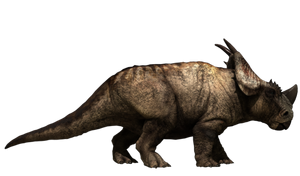Gojira2018 (talk | contribs) Tag: Visual edit |
No edit summary Tag: Visual edit |
||
| Line 17: | Line 17: | ||
Other appearances: Biggest Killers, Armageddon}}''' |
Other appearances: Biggest Killers, Armageddon}}''' |
||
| − | '''Pachyrhinosaurus''' ("thick-nosed lizard") is a genus of ceratopsid dinosaurs from the Late Cretaceous period of North America. (77- |
+ | '''Pachyrhinosaurus''' ("thick-nosed lizard") is a genus of ceratopsid dinosaurs from the Late Cretaceous period of North America. (77-66 MYA) |
Pachyrhinosaurus appears in the episode, "River of Death", and later in the final episode, "Armageddon". |
Pachyrhinosaurus appears in the episode, "River of Death", and later in the final episode, "Armageddon". |
||
Revision as of 19:01, 6 March 2018
|
Herbivores
| |
|
Species
|
Pachyrhinosaurus
|
|
Size
|
26 feet (8 meters) long, 10 feet (3 meters) tall with frill, 4.4 tons
|
|
Abilities/weaponry
|
Armored skull, spined neck frill, horn, head, speed, large size, strength, beak, jaw strength, senses
|
|
Turf
|
Canada, North America
|
|
Timespan
|
Late Cretaceous 76-68 Ma
|
|
Appearances
|
First appearance: "River of Death"
Other appearances: Biggest Killers, Armageddon
|
Pachyrhinosaurus ("thick-nosed lizard") is a genus of ceratopsid dinosaurs from the Late Cretaceous period of North America. (77-66 MYA)
Pachyrhinosaurus appears in the episode, "River of Death", and later in the final episode, "Armageddon".
Description
Measuring up to 8 m. ( 26 ft.) long, standing over 7 feet tall, and weighing in at as much as 4.4 tons, Pachyrhinosaurus was one of the largest types of ceratopsid (or horned dinosaurs). Unlike other ceratopsids, however, the adult Pachyrhinosaurus didn't have a nose horn to go with the two horns on its brow. Instead, it had a large, wrinkly bone mass covering its nose, earning it its name, which means "thick-nosed lizard."
Fighting style
Pachyrhinosaurus probably lived and traveled in herds for feeding and protection reasons: When one dinosaur spotted a predator, he could alert the rest of the herd. Its primary weapon was its armored skull, which it used for ramming its attackers. When confronted with a predator, Pachyrhinosaurus would lower its head and charge forward, then raise its head up quickly and attempt to wound its opponent. Another distinctive ceratopsid feature--the bony headdress-like frill at its neck--could be used as protection for the rest of the body, which was unarmored and vulnerable. Additionally, Pachyrhinosaurus were also fast for dinosaurs of their size, let alone, a ceratopsian, capable of running at 25 miles an hour.
Diet
The giant Pachyrhinosaurus was herbivorous. It was preyed on by the giant carnivorous tyrannosaurids that shared its geographical range and time period, most notably Albertosaurus.
Trivia
- In the 1980s, an entire herd of Pachyrhinosaurus skeletons was found in Alberta, Canada. Studying these fossils, especially those of baby and juvenile dinosaurs, helped paleontologists determine that the disappearance of the Pachyrhinosaurus nose horn in favor of the bulbous nose was not a result of illness, as had previously been thought, but a normal characteristic that developed at the time of puberty.
(http://www.history.com/interactives/dinopedia)
- In 2011 the plot of the "River of Death" episode was used in the third episode of Planet Dinosaur series.
- This dinosaur doesn't looks like patchyrhinosaur looks like another type of dinosaur in the family because the horn is post to be on his head not on the mouth.




